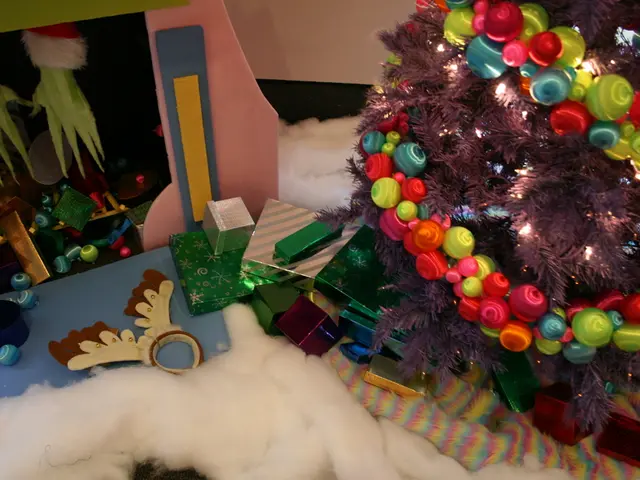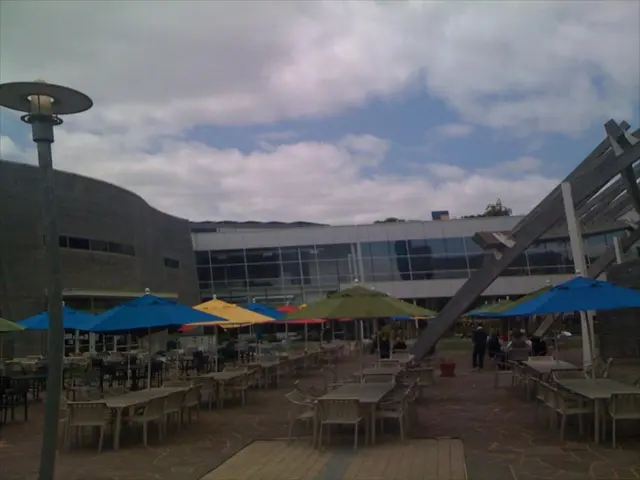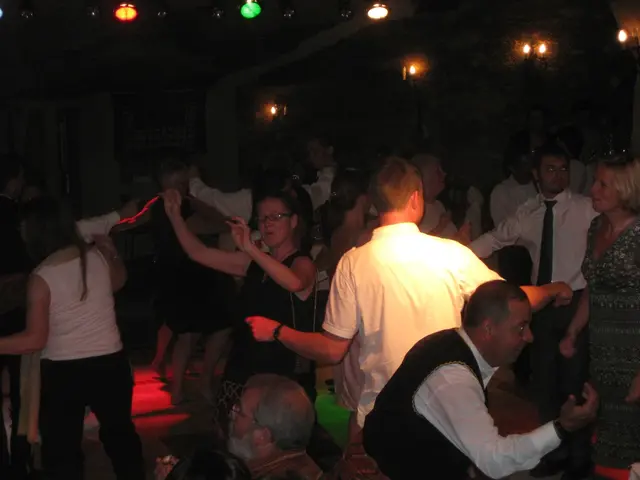Choosing the Perfect Wood Floor Colour: A Guide for Interior Design
Timeless Home Design Ideas Featuring 24 Variaited Wood Floor Colors
Wood floors, a timeless and adaptable choice, can significantly influence a space's aesthetics and ambiance. From classic to modern, rustic to unique finishes, each wood floor colour offers distinct advantages and disadvantages for interior design.
General Advantages of Wood Floors
- Timeless and Adaptable: Neutral tones, such as natural oak, provide a versatile backdrop suitable for a wide range of design styles, from traditional to contemporary[1].
- Warmth and Comfort: Wood floors offer a naturally warm, inviting, and comfortable surface underfoot, providing a welcome contrast to tiles[2].
- Durability: Many woods, such as oak and walnut, are durable and long-lasting, adding value to a home.
- Design Flexibility: The variety in grain, colour, and finish allows for customisation, ensuring a floor that matches almost any décor vision.
General Disadvantages of Wood Floors
- Susceptibility to Damage: Wood floors can be scratched, dented, and may wear over time.
- Sensitivity to Moisture: Most woods are not ideal for wet areas without proper sealing.
- Higher Cost: Hardwoods and exotic species are often more expensive than engineered woods, laminates, or bamboo.
- Maintenance: Some finishes require periodic reapplication, and lighter colours may show dirt and stains more easily.
Detailed Comparison by Colour/Type
Each wood floor colour and finish carries its unique advantages and disadvantages, influencing the ambiance, perceived space, and ease of maintenance.
Classic Natural Oak
- Advantages: Neutral, natural appeal; flexible for most colour schemes; timeless; durable.
- Disadvantages: Can be common, lacking in uniqueness; may show dirt and minor scratches over time.
Elegant White Oak
- Advantages: Light, airy look makes rooms feel larger; neutral with cool undertones; complements both modern and classic styles.
- Disadvantages: Scratches and wear may be more visible on lighter floors.
Warm Red Oak
- Advantages: Adds warmth and character; traditional but still flexible.
- Disadvantages: Red tones may not suit all colour palettes; can look dated if not paired thoughtfully.
Smooth Maple
- Advantages: Subtle, light grain; clean, modern look; durable and smooth surface.
- Disadvantages: Hardness can make refinishing difficult; light colour shows scuffs.
Rich Cherry
- Advantages: Deep, luxurious tone; ages beautifully with a natural patina.
- Disadvantages: Expensive; darkens with exposure to light; may clash with strong wall colours.
Durable Walnut
- Advantages: Very hard, durable; rich, dark colour; elegant and sophisticated.
- Disadvantages: Expensive; darker tones can make rooms feel smaller and show dust/lint.
Rustic Hickory
- Advantages: Distinctive grain and colour variation; adds warmth and character; hard and tough.
- Disadvantages: Color variation may be overwhelming in small spaces; less neutral than other options.
Sustainable Bamboo
- Advantages: Eco-friendly; harder than many traditional hardwoods; modern look.
- Disadvantages: Can be prone to scratching; limited style options; may not suit all aesthetics.
Natural Cork
- Advantages: Soft underfoot; excellent sound absorption; eco-friendly; hypoallergenic.
- Disadvantages: Susceptible to dents and moisture; requires sealing; less common in upscale interiors.
Versatile Ash
- Advantages: Light, neutral tone; fine, attractive grain; good for a casual or modern look.
- Disadvantages: Not as hard as oak; may require more maintenance.
Charming Pine
- Advantages: Soft, warm look; affordable; rustic charm.
- Disadvantages: Prone to dents and scratches; may require more upkeep.
Douglas Fir
- Advantages: Affordable; warm, honey-toned appearance; traditional look.
- Disadvantages: Softer than hardwoods; more prone to wear.
Brazilian Cherry (Jatoba)
- Advantages: Extremely hard and durable; exotic, deep red-brown colour.
- Disadvantages: Expensive; colour change with light; can easily overwhelm a space.
Dark Wenge
- Advantages: Dramatic, modern look; very dark, almost black; exotic and unique.
- Disadvantages: Makes rooms feel smaller; shows dust and scratches; expensive.
Classic Ebony
- Advantages: Ultra-dark finish; sophisticated, modern, or minimalist look.
- Disadvantages: Expensive; can feel cold or stark; shows dust and scratches readily.
Gray Wash
- Advantages: Modern, on-trend look; neutral base for colourful accents; hides dirt.
- Disadvantages: May look trendy now but could date quickly; lacks warmth of natural wood tones[1].
Bright Bleached White
- Advantages: Opens up small spaces; modern, airy feel; hides minor scratches.
- Disadvantages: Shows dirt easily; can look sterile; may be difficult to maintain pristine.
Warm Honey Tone
- Advantages: Inviting, sunny appearance; versatile for many décor styles; hides dust well[1].
- Disadvantages: Somewhat common; may not suit all modern palettes.
Earthy Coffee Brown
- Advantages: Rich, grounded look; hides dirt and wear; versatile for different decors.
- Disadvantages: Can darken a room; may feel dated if not styled thoughtfully.
Characterful Rustic Brown
- Advantages: Adds texture and visual interest; warm, lived-in feel; unique.
- Disadvantages: May not suit all interiors; can be difficult to coordinate with other finishes.
Modern Charcoal
- Advantages: Bold, contemporary look; hides dirt; pairs well with industrial or modern décor.
- Disadvantages: Too dark for some rooms; can feel stark; may not age well with trends.
Radiant Golden Oak
- Advantages: Bright, cheerful look; traditional yet fresh.
- Disadvantages: Can look dated if paired with older furnishings.
Soft Creamy Beige
- Advantages: Warm, neutral look; easy to match with other colours; hides dust and scratches.
- Disadvantages: May feel too safe or bland; less bold than other choices.
Unique Distressed Finish
- Advantages: Adds vintage character; hides scratches and wear; unique in each installation.
- Disadvantages: May not suit all styles; edges and textures can trap dirt.
Additional Considerations
- Maintenance: Lighter woods and bleached finishes often hide minor scratches better, while dark and exotic woods show dust and scratches more readily.
- Room Size and Lighting: Light floors can make small spaces feel bigger and brighter; dark floors can add coziness but may make small rooms feel closed in.
- Trends: Neutral, classic woods like oak and ash remain timeless, while gray or bleached finishes are trend-driven and may look dated sooner[1].
- Value: Durable, hard woods and exotic species can increase property value, but may not appeal to all buyers.
- Sustainability: Bamboo and cork are eco-friendly alternatives, though they may lack the longevity or prestige of traditional hardwoods.
Summary Table
| Floor Type | Main Advantages | Main Disadvantages | |---------------------------|-----------------------------------------|--------------------------------------| | Classic Natural Oak | Timeless, neutral, flexible | Common, may show wear | | Elegant White Oak | Airy, modern, neutral | Scratches more visible | | Warm Red Oak | Warm, traditional, character | Can look dated, color limits palettes| | Smooth Maple | Clean, modern, durable | Hard to refinish, shows scuffs | | Rich Cherry | Luxurious, ages beautifully | Expensive, darkens over time | | Durable Walnut | Hard, durable, elegant | Expensive, shows dust | | Rustic Hickory | Distinctive, warm, tough | Overwhelming in small spaces | | Sustainable Bamboo | Eco-friendly, hard, modern | Prone to scratches, limited styles | | Natural Cork | Soft, quiet, eco-friendly | Dents, moisture issues, less upscale | | Versatile Ash | Light, neutral, casual/modern | Softer, more maintenance | | Charming Pine | Affordable, rustic, warm | Prone to dents, scratches | | Douglas Fir | Affordable, traditional, warm | Soft, wears easily | | Brazilian Cherry (Jatoba) | Extremely hard, exotic, durable | Expensive, color changes, bold | | Dark Wenge | Dramatic, modern, unique | Expensive, shows dust, small feel | | Classic Ebony | Sophisticated, ultra-dark, modern | Expensive, stark, shows wear | | Gray Wash | Modern, neutral, hides dirt | Trendy, may date, lacks warmth[1] | | Bright Bleached White | Opens space, modern, hides scratches | Shows dirt easily, can look sterile | | Warm Honey Tone | Inviting, versatile, hides dust[1] | Common, may not suit all palettes | | Earthy Coffee Brown | Rich, hides dirt, versatile | Can darken room, may feel dated | | Rustic Brown | Character, texture, unique | Hard to coordinate, traps dirt | | Modern Charcoal | Bold, contemporary look | Stark, may not age well, dark | | Golden Oak | Bright, cheerful look | Can look dated | | Creamy Beige | Neutral, hides wear, easy to match | Safe, may lack character | | Distressed Finish | Vintage, hides wear, unique | May not suit all styles, traps dirt |
Conclusion
Choosing the right wood floor colour involves balancing practicality, personal style, and the architectural context of your space. Neutral, natural tones are timeless and flexible, while bold or trend-driven choices make a statement but may require more careful styling and maintenance. Always consider the room’s size, lighting, and your long-term décor plans when selecting a wood floor colour and finish.
[1] These statements are based on current trends and may change over time.
- In the realm of fashion-and-beauty, the versatility of a neutral-toned foundation, like a natural oak wood floor, provides an excellent canvas for a wide range of style choices.
- A home-and-garden refresh with a smooth maple floor adds a clean, modern look in line with current lifestyle trends, making it a suitable choice for both casual and contemporary décor.








